Maxwell Stevens’ Subtle and Layered Beach Paintings

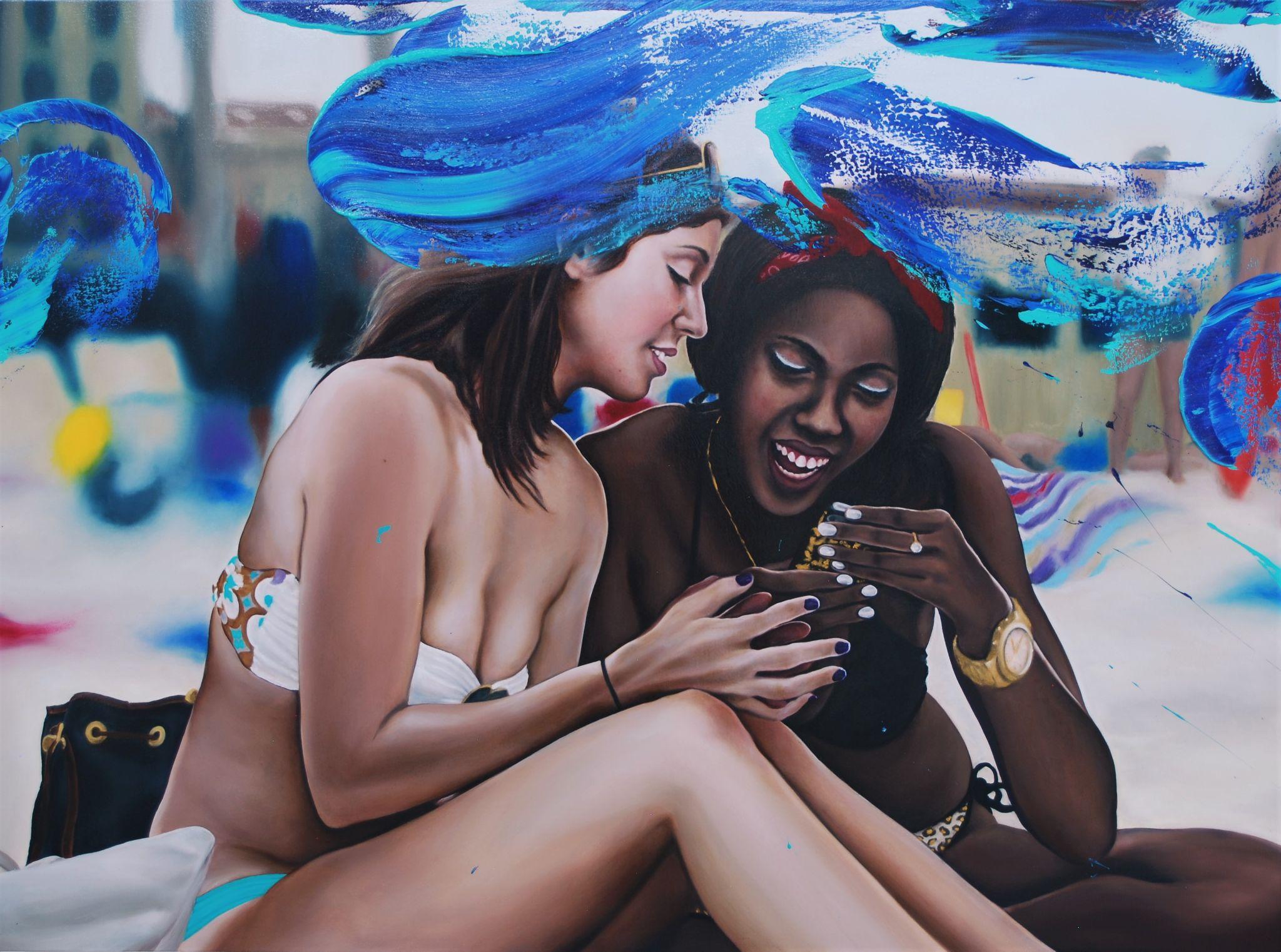
In a recent interview with Vanity Fair, the musician Bad Bunny said that since he moved to LA he set aside time to go to his local beach every week to relax. For the painter Maxwell Stevens, who spent his formative years in Florida, the beach is an important place to be, decidedly sacred. Like Bad Bunny’s lyrics, some of Stevens’ oil paintings that merge figuration with abstraction sizzle with sexual innuendo while others convey sensations of stillness or communion amongst friends and family. The beach is a place for everyone—where the dense visuals of nature, objects, bodies, and shifting light set a stage for the private to become public.
“I needed to be careful about the works not becoming too nostalgic,” Stevens explains during my visit to his studio in Long Island City. The subject is tricky, risking to veer toward postcard-perfect stagings of the natural landscape, or, disjointed compositions haphazardly layering different beachgoers. However, Stevens has managed to capture the tempo and versatility of the beach and what goes on there, in its subtlety. His solo exhibition “Last Days of Summer” which was on view at ONETWENTYEIGHT closed on October 15. Pictures of the works on Instagram caught my eye, but I am astounded by how different it is from seeing the pieces in person, especially those set in the daytime light. I was able to see most of the works installed in his studio instead of the Lower East Side gallery. Rather than flat, the density of pigment and texture of the brushstroke and variation of transparency and opacity are all the more clear IRL.
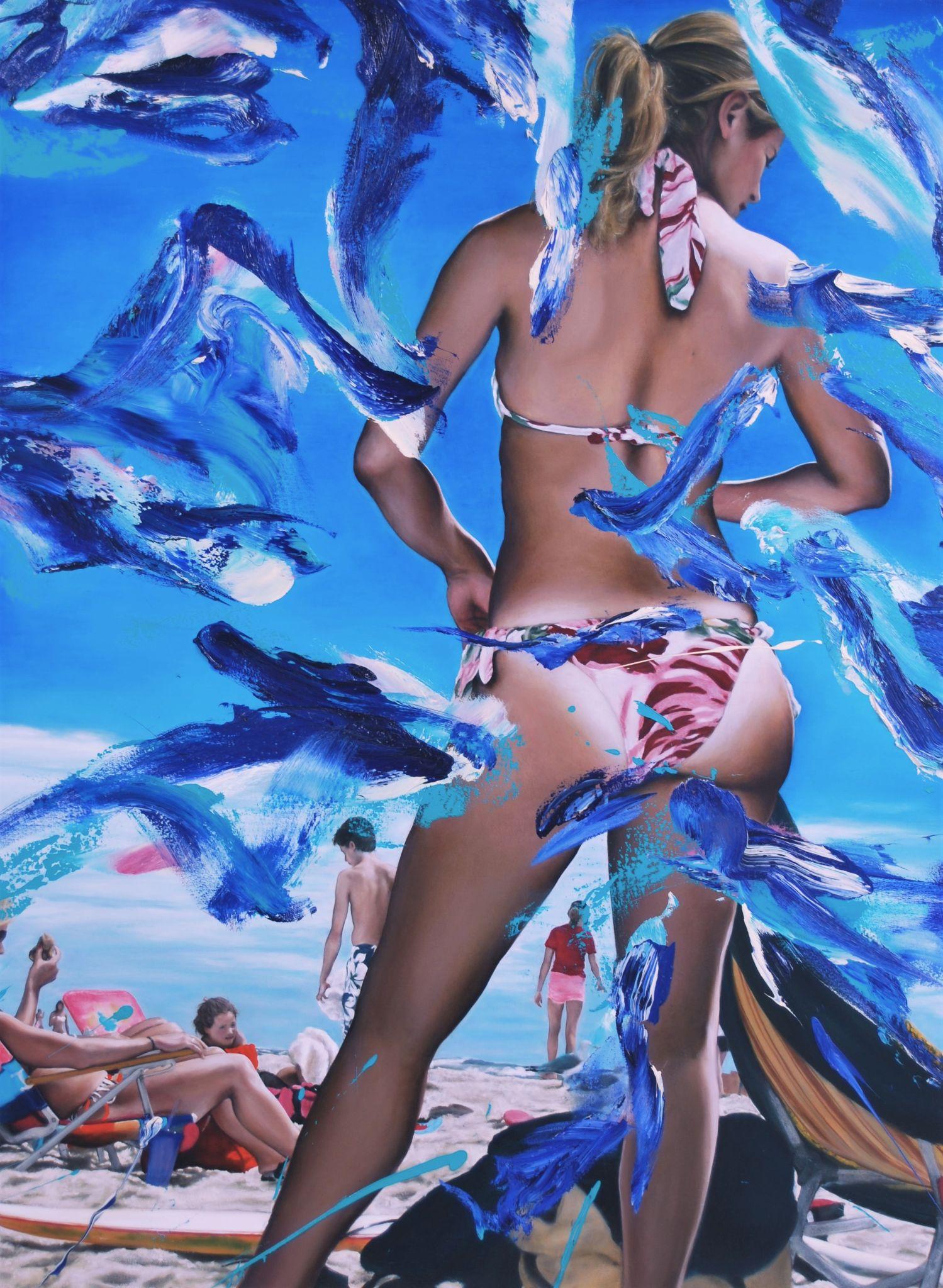
In Bikini Girl, a dark blonde woman towers in the picture plane, with a figure in pink trunks between her legs. We see her from behind in a light pink bikini, legs spread, hands on hips, and in the triangular sightline between her legs, a person appears. Perhaps she is fixating her gaze on them? The composition is humorous and sexy. Off to the left, another sunbather is looking at her, away from the youth next to him. The woman beside him comfortably sits in a beach chair uncaring. Characteristic of this series are the abstract brushstrokes that overlay parts of the image; the thick energetic strokes streak her legs, buttocks, and parts of her back. Like sunscreen not yet absorbed by the body, it obscures the image. It is an unabashed but also unthreatening depiction of everyday voyeurism. This juxtaposition of desire and banality is fun, in a disarming way.
ONETWENTYEIGHT, opened in 1986, by the artist Kazuko Miyamoto is the longest-running gallery in the Lower East Side. Reviewing her retrospective at Japan Society in 2022, Holland Cotter called her an “integral but underknown member of New York City’s downtown art community for more than 50 years.” Although her practice is minimalist—she both worked and was friendly with Sol LeWitt, “one of LeWitt’s pieces drawn directly on the gallery wall, is still there, embedded in the wall,” Stevens chuckles—Miyamoto shows a diverse set of artists at her gallery and has exhibited Stevens several times. He was also represented by Björn Ressle, the prolific New York-based Swedish gallerist.
Maxwell Stevens’ “Last Days of Summer” series marks a return to figuration for the artist. The works are based on photographs that he has taken at his many visits to the beach over the years. Usually, he goes in the summer with his wife, mostly to Long Beach which is located on the western part of Long Island’s South Shore. “All of the works follow photographs, verbatim,” he tells me. In comparison to Winslow Homer’s meditative yet cheerful East Hamptons Beach, Long Island painted in 1874 depicting a group of women on the beach, Stevens’ work has much more movement. If he has a suite of photographs, he takes the gesture from one snapshot and includes it in another. For example, in Beach Scene (Siblings) the boy was not touching his face in the same frame as the woman fixing her hair, it happened a moment later. This retouching adds to the busyness of his works that bring together multiple groups of people.
More than a decade ago, the artist abandoned figurative painting, in search of the truth— “ figurative painting was an illusion,” he explains. Trained rather classically, Stevens earned his degree at The Atlanta College of Art which became SCAD Atlanta in 2006. There he studied figure drawing with Fred Gregory who had studied under Joseph Albers and Willem de Kooning and painting with Mildred Thompson, among others. Apt at close looking and a master of technique, he worked with figuration for many years but was tired of finding that his paintings could never quite fully reflect reality—which abstract painting, that captures essence and energy could do better. In his beach paintings, he has merged both, creating a palpable tension within the picture plane by this engagement with formalism but also its relationship to the subject matter.
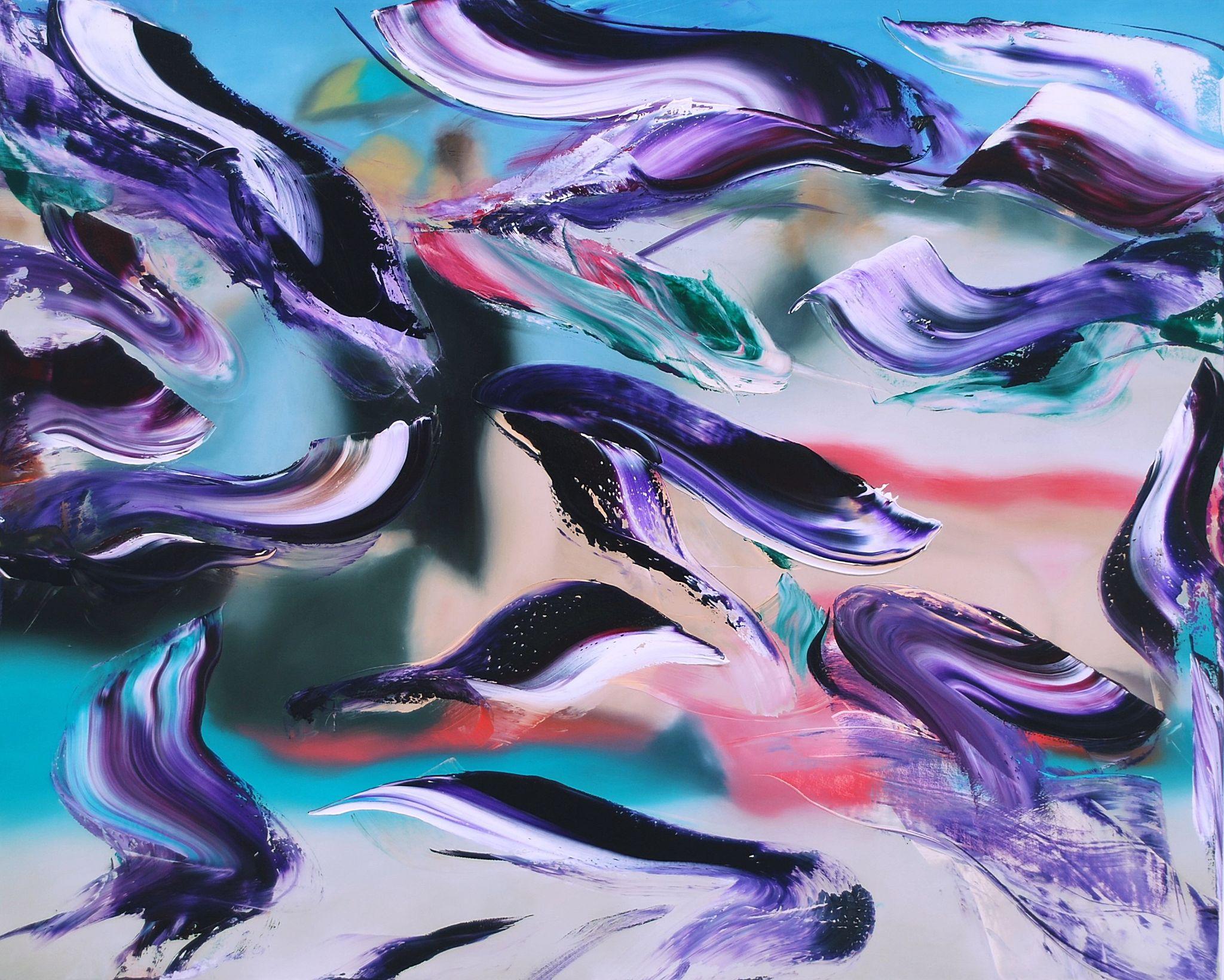
Skin, and especially that of his female subjects, is enigmatic in Stevens’ daytime beach paintings. It is voluminous through its reflection and refraction of light, he has used white tones to bring a shininess to the skin that the high noon sun is beating down on. Beach Scene (Friends) picturing two larger-than-life women whose limbs are on display side by side is a good example. “I use glazes,” he tells me. First, he paints a base color, builds upon that, and mixes the paints with glazes to achieve a more translucent effect. When he paints he uses an image on his laptop as a reference—“the brightness is never quite correct,” he says. The light changes throughout the process; a photograph will not translate the same light as reality, and a screen display will further alter its colors. However, working with digital tools has allowed Stevens to add another layer to his engagement with abstraction. In some works, he blurs parts of the image before he paints them. In these works he also paints with strokes of gestural abstraction—thus the works include two layers of abstraction, one created digitally and the other created during the painting process.
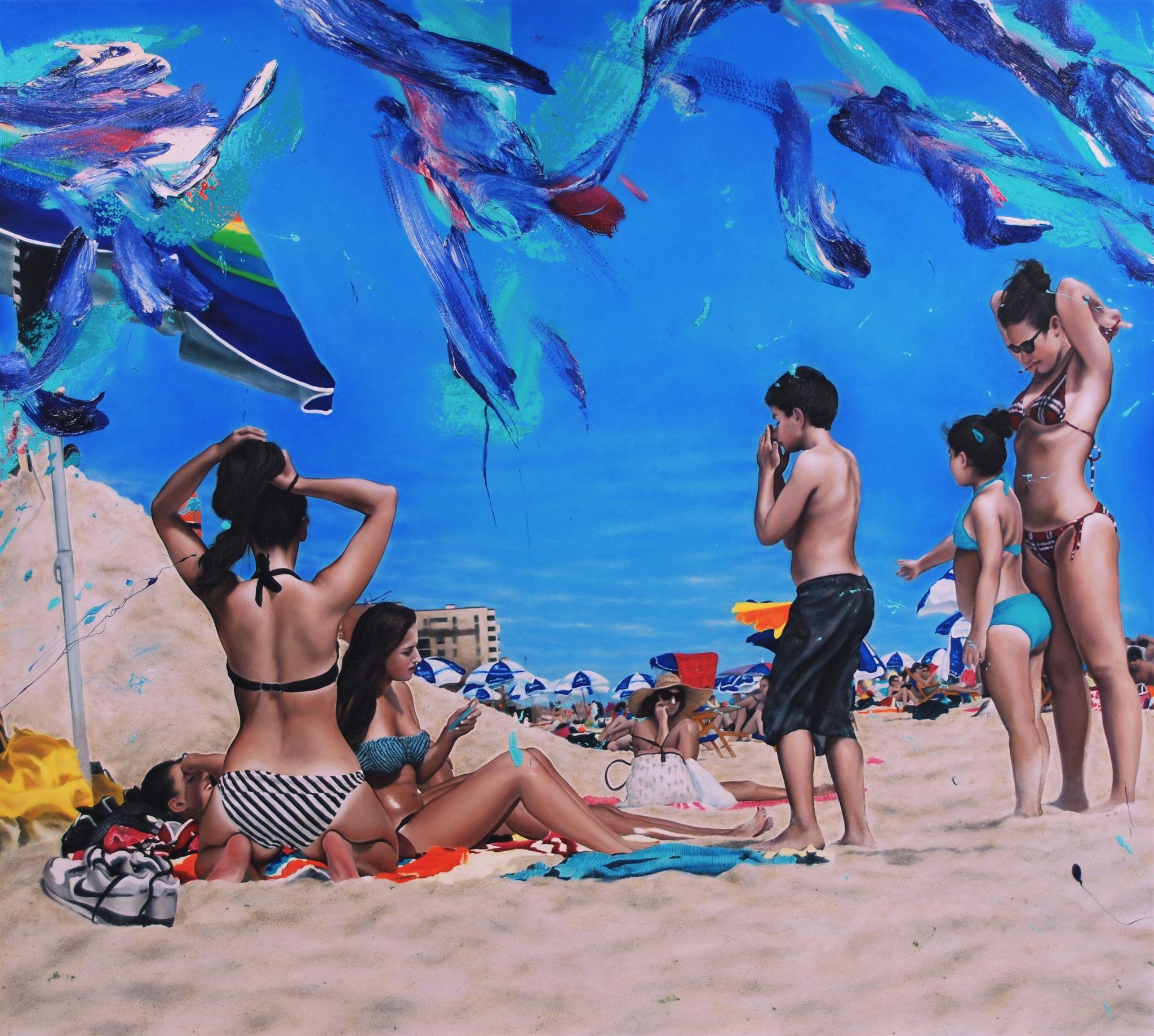
Beach Scene, In Repose, depicts a man, lying tilted to one side and resting on his elbow. Caught in a moment he seems to be looking down, at something, maybe his phone while the two women on his right are in conversation, no one, except the photographer and viewer of the painting, pays him mind. At a closer look, everyone in Maxwell Stevens’ paintings is doing something. In Beach Scene, Siblings, a boy slouches, looking down, pondering, while a woman seems to be adjusting the back of her bikini. Thought processes of viewing others, in public, ignite as I gaze over the works. The truth that Stevens captures in his paintings is perhaps not, like a photograph, simply a representation of the visual scene itself, but instead the energy of those things and people who are keenly aware of being seen and those who are not. While the waves will break the shore independently of being watched or not, someone might decide to adjust their hair or bikini a certain way based on who is watching, or because others are around–while others are oblivious or uncaring.
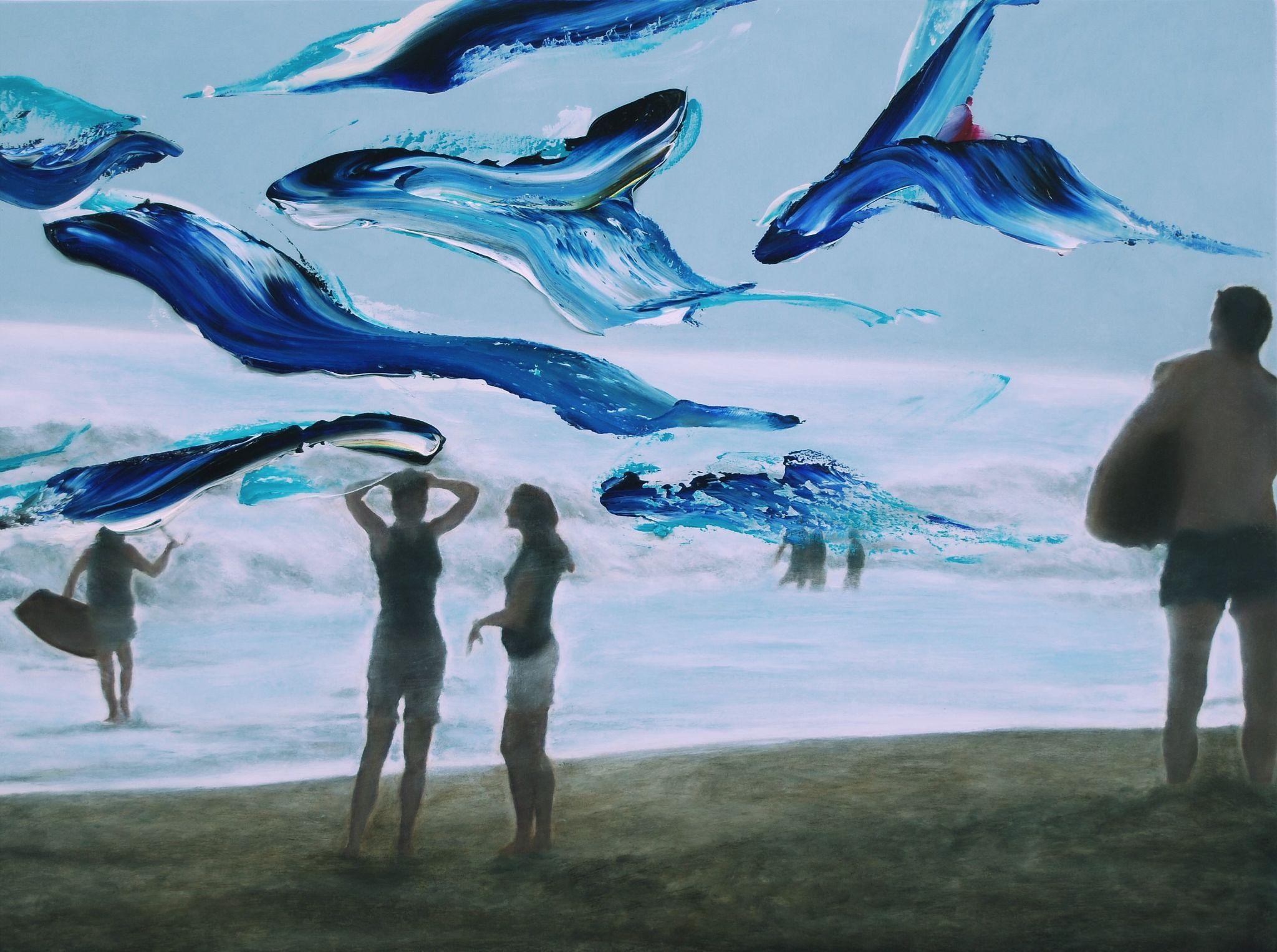
Three smaller works, depicting the beach at dusk, help convey the scope of emotion and activity that changes as the day progresses. These works are quieter, the figures are smaller as they are portrayed from further away—the magnitude of the horizon takes precedence over the people within the landscape. They capture a moment of stillness, or suspension in time and place that dusk at the beach brings. In these works, Stevens employs a more romanticized nineteenth and twentieth-century style akin to the Hudson River Painters, or other schools that painted beach scenes, such as The Skagen Painters. With its expressive brushstrokes, the overall series also nods to the Abstract Expressionists who traveled out east to paint the landscape including Helen Frankenthaler, Mary Abbott, and Willem and Elaine de Kooning, among others.
Apart from his engagement with Long Island with its nod to Abstract Expressionism, the tension between figurative and abstraction in Stevens’ works in this series lies in this uncertainty, of knowing and not knowing, concealing and revealing. The uncertainty of knowing if you are being watched, or the person you are looking at knows you are watching them, or if they even care. In public, we exist within our microcosms—a group of friends, family, or simply alone, but we are also visible to others and these microcosms can easily be punctured and expanded through conversation, gestures, or looks that allow our surroundings to shift.
You Might Also Like
What's Your Reaction?
Anna Mikaela Ekstrand is editor-in-chief and founder of Cultbytes. She mediates art through writing, curating, and lecturing. Her latest books are Assuming Asymmetries: Conversations on Curating Public Art Projects of the 1980s and 1990s and Curating Beyond the Mainstream. Send your inquiries, tips, and pitches to info@cultbytes.com.

